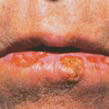 Actinic cheilitis is a form of actinic keratosis (AK) that appears on the lip as a result of chronic sun damage. Actinic cheilitis usually occurs on the lower lip.
Actinic cheilitis is a form of actinic keratosis (AK) that appears on the lip as a result of chronic sun damage. Actinic cheilitis usually occurs on the lower lip.
Actinic cheilitis occurs most commonly in those with a history of excessive sun exposure, particularly older males, those with a light complexion and have a history of smoking. People with actinic cheilitis are also more likely to have actinic keratoses on the face, scalp or arms.
Actinic cheilitis may appear as a whitis or gray lesion that persists. The lesion itself is usally painless, but frequent lip-licking can lead to irritated, chapped lipts. As the lesion grows, it may become more swollen and scaly. The vermillion border (the border between the pink lip and skin) may also become obscured.
Actinic cheilitis is considered PRECANCEROUS and has the potential to become a type of skin cancer called squamous cell carcinoma (SCC). Therefore, your doctor will be diligent in diagnosing, treating, and monitoring your skin after diagnosing actinic cheilitis. Also, since actinic cheilitis results from chronic sun exposure, those with these lip lesions are at risk for developing skin cancer elsewhere on their bodies.
Fortunately, actinic cheilitis can be treated effectively when diagnosed early. Treatment options include the following:
- Cryotherapy
- Medications applied to the lesion (imiquimod, 5-FU, topical retinoids)
- Photodynamic therapy (PDT)
- Surgical procedures, inlcuding electrosurgery, laser ablation and, in severe cases, removal of the lip (vermilionectomy)
Steps to prevent the development or recurrence of actinic cheilitis include the following:
- Limit sun exposure
- Wearing a hat with a wide brim that covers the face
- Use a lip balm with sunscreen
- Stop smoking
Source: Vivacare
Last updated : 2/8/2021